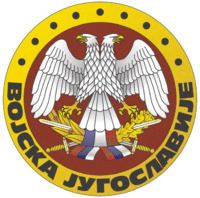Disbanded June 5, 2006 | Military age 19 years Founded 20 May 1992 | |
 | ||
Commander-in-Chief President Dobrica Ćosić (1992–1993)President Zoran Lilić (1993–1997)President Slobodan Milošević (1997–2000)President Vojislav Koštunica (2000–2003)President Svetozar Marović (2003–2006) Commanders of General Staff HQ Colonel General Života Panić (1992–1993)Colonel General Momčilo Perišić (1993–1998)General of the Army Dragoljub Ojdanić (1998–2000)Colonel General Nebojša Pavković (2000–2002)Colonel General Branko Krga (2002–2004)Lieutenant General Dragan Paskaš (2004–2005)Lieutenant General Ljubiša Jokić (2005–2006) Military conflicts Bosnian War, Kosovo War, Insurgency in the Preševo Valley, 13 April 1999 Albania–Yugoslav border incident Similar Serbian Armed Forces, Serbian Army, Yugoslav People's Army, Yugoslav Air Force, Yugoslav Ground Forces | ||
The Armed Forces of Serbia and Montenegro (Serbian: Војска Србије и Црне Горе/Vojska Srbije i Crne Gore; ВСЦГ/VSCG) included ground forces with internal and border troops, naval forces, air and air defense forces, and civil defense. Preceding the VSCG was the Armed Forces of Yugoslavia (1992–2003) (Војска Југославије/Vojska Jugoslavije, ВЈ/VJ) from the remnants of the Yugoslav People's Army (JNA), the military of SFR Yugoslavia. The state, then named Federal Republic of Yugoslavia, participated in the Yugoslav Wars with limited direct intervention of its own armed forces. Following the end of the Wars and the constitutional reforms of 2003 by which the state was renamed "Serbia and Montenegro", the military accordingly changed its name. The military was heavily involved in combating Albanian separatists during the Kosovo War and Preševo Valley conflict, and also engaged NATO airplanes during the 1999 NATO bombing of Yugoslavia.
Contents
- Artillery
- Air Defence
- Infantry Weapons
- Navy
- Intelligence
- Operational experience
- Statistics
- Branches
- International Deployment
- References
Upon the dissolution of Serbia and Montenegro with the Montenegrin independence referendum (2006), a fraction of the joint military was given to Montenegro, with the bulk of the force remaining in Serbia. Montenegro inherited the navy as Serbia is landlocked.
Artillery
Air Defence
Infantry Weapons
Navy
The Federal Yugoslav Navy was based in the Kotor and was largely made of vessels inherited from the SFR Yugoslav Navy. During NATO's Operation Allied Force in 1999, the Navy took control over civilian shipping around Kotor, despite NATO's blockade and in several actions the navy's warships fired at NATO aircraft that were on their way to strike targets. The Navy claimed to have shot down three UAVs over Boka Kotorska. The images of the remains of one of them were displayed online.
Intelligence
Operational experience
Statistics
Civilians fit for military service were estimated at about 4,888,595 (2001 est.). The 2002 estimate for military expenditures as percent of GDP was 4.6%. Significant reforms were undertaken in the military of Serbia and Montenegro. In 2002 the Serbo-Montenegrin Military force numbered around 100,000 soldiers, supported by some 450,000 reserves. The 100,000 strong Army had 1,500 main battle tanks and 687 armed infantry vehicles. The Navy had 3,500 personnel, of whom 900 were marines. The entire Navy was composed totally out of 6 submarines, 3 frigates, 41 patrol & coastal ships and 14 "other" vessels. The Air force 14,000 personnel had 192 combat aircraft and 72 armed helicopters.
Branches
Military manpower – military age: 19 years of age (2003 est.)
Military manpower – availability:
males age 15–49: 3,579,620 (2003 est.)
Military manpower – fit for military service:
males age 15–49: 3,077,660 (2003 est.)
Military manpower – reaching military age annually:
males: 101,547 (2003 est.)
Military expenditures – dollar figure: $954 million (2002)
Military expenditures – percent of GDP: 4.6% (2002. est.)
International Deployment
The VSCG was part of MONUC, the UN mission in the Congo. The VSCG was also part of UNAMSIL, the UN mission into Sierra Leone.
Last chief of staff of the Military of Serbia and Montenegro was general Ljubiša Jokić.
